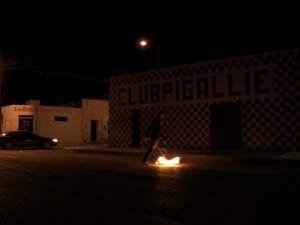The long trek from the Yorkshire Sculpture Park Centre to the Longside Gallery refreshes and furnishes the soul of the city dweller with a graceful marriage of nature and artifice. The verdant undulations of the sculpted terrain punctuated with wooded areas, and surrounding the main focal points of the lake and Bretton Hall, suffice to pervade the senses with an impression of organic unity. This general impression is heightened by the dynamism of passing clouds in the sky evoking an almost spiritual wonder at the apparent unity of their form, while being derived from random constituents. This works nicely as an appetizer to Flashback: a survey of Anish Kapoor’s work and development, spanning 18 years from 1982 to 2000. Why? The visitor is presented with highly sensual, organic and abstract forms exploring positive and negative space with a remarkably original employment of materials. Moving forward chronologically, the exhibition can be seen as consisting of two parts with an intervening transition.
The earliest works exhibited from 1982, White Sand, Red Millet, Many Flowers, and, Red in the Centre, employ mixed media and, most importantly, pigment. Indeed, the bold use of colour in the former, used homogeneously in each constituent piece, calls out for an accompanying redolence, and fascinates the viewer. This is owing to the matt, apparently natural and organic forms arranged, that invoke dye and spice. This can be felt to resonate with experience of the East. The latter invokes, perhaps, elements of botanical interest; certainly with the detailed accuracy of the measured execution and matt finish. Here is a seed, there is a stamen perhaps, but writ large. Yes, the scale is balanced just right to be modest, yet allows charisma. Part of this work is mounted on the wall, bold red in colour – a stark and alarming contrast to the grey-brown of the pieces on the floor. The use of red here initially horrifies the viewer for the connotations of danger in nature. This impression is compounded by the convincing sense of the organic evoked by the form. Again, using mixed media and pigment, from 1983 we find the piece, Untitled. In shape it is largely conical, and man-sized. The use of matt black pigment gives the impression that no light can escape from it, that it is all absorbing, rather like a black-hole. The detail of the sculpted surface of the object creates an impression of a sort of vortex with elements of the natural and the organic; particularly the floral. The bold use of black in this floral, free-standing vortex is viscerally irksome. Its seems dangerous. It can be felt to strike the viewer as one of the vacuums so abhorred by nature.
The use of a largely conical form in Untitled, foreshadows the theme of positive and negative space so important to the later works. The piece Adam (1988-89), however, although using pigment (and sandstone) seems somewhat out of place. While negative space is employed – the piece employs a large sandstone block with a rectangular, three-dimensional space removed – it does not have that natural, organic sense about it. This is probably because of the use of a rectangle (or cuboid) rather than a circular form. Such is evident in Void (1994). A wall mounted, conical form made from fibreglass and pigment. This has a similar sense of all absorbing danger to Untitled, but without the floral element. It is blue and equally daunting, but now because of a sort of universal, perhaps cosmological, sense of the elemental. This can be said of the remaining, later works, which use mirrored surfaces rather than pigment.
From 1995 we are presented with Turning the World Inside Out, and , Untitled. The former, made from stainless steel and large-scale, is a slightly flattened sphere with a sort of inverse conical form removed from it. This distorted form engages and includes the viewer and the surrounding space with the reflective surface. Owing to the scale and the perfection of the artistry, the piece daunts the viewer as though it were an abstraction of one of the elements from the Platonic Realm of Ideals. The same can be said of the latter, which is wall mounted. Again in stainless steel, the piece distorts the viewer from a concave, this time imperfect, impression. Neither piece seems to belong in this world, yet seems intimately related to it.
The most recent pieces in this exhibition, Her Blood (1998), and, Turning Water into Mirror, Blood into Sky (2000). Are more familiar, perhaps more human, though equally daunting. Her Blood, made from stainless steel and lacquer, consists of three enormous, larger-than-life, slightly convex, relfective discs that lean against the wall. One of them is red in colour, echoing the blood of the title. The optical effect in reflecting the viewer is both repulsive because of the daunting scale, yet attractive because it is fascinating. Turning Water into Mirror, Blood into Sky does as the title states. It consists of a sort of horizontally rotating metal vat containing a dark, blood-like, reflective concave surface. Heightened by the ‘Blood into Sky’ of the title, the accuracy of the physical execution imparts a sense of the deeply spiritual and deeply human with overtones of Armageddon. This is typical of the sublime nature of the majority of the works on display.
Anish Kapoor: Flashback, 16/06/2012 until 04/11/2012, Yorkshire Sculpture Park, West Bretton, Wakefield, WF4 4LG. www.ysp.co.uk
Credits:
1. Anish Kapoor, Longside Gallery.
2. Anish Kapoor, Red in the Centre, 1982 © National Museums Liverpool, Walker Art Gallery.
3. Anish Kapoor, Untitled, 1983 © Scottish National Gallery of Modern Art, Edinburgh.
4. Anish Kapoor, Untitled, 1995 Stainless steel, Arts Council Collection, Southbank Centre, London. Acquired with the assistance from The Henry Moore Foundation, 1998 © Anish Kapoor
Photo: Jonty Wilde
Text: Daniel Potts




